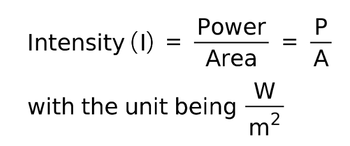I am sure you have noticed that the brightness of light changes depending on how close you are to the source of that light. A car headlight can appear dimmer than a candle, if the candle is one centimetre away from your eye and the headlight a significant distance away.
A fundamental principle of waves is that although the energy emitted by a luminous object is the same, its brightness, or better term, its intensity is determined by the distance.
A light source emits a certain amount of energy (E). If we divide this amount by time, we have the rate of energy released, which is the power of the light source.
The unit being the Watt (W)
This value is independent of the distance viewed.
The intensity (I) is the power per unit area and so
A fundamental principle of waves is that although the energy emitted by a luminous object is the same, its brightness, or better term, its intensity is determined by the distance.
A light source emits a certain amount of energy (E). If we divide this amount by time, we have the rate of energy released, which is the power of the light source.
The unit being the Watt (W)
This value is independent of the distance viewed.
The intensity (I) is the power per unit area and so
Intensity IS dependent on the distance viewed.
As distance increases by a a certain factor, the intensity observed decreases by that factor SQUARED.
For example, if a source of light is viewed from a certain distance, and the distance is then doubled, the intensity drops by a factor of 4.
As a result , the relationship between intensity and distance is classified as an inverse square relationship
As distance increases by a a certain factor, the intensity observed decreases by that factor SQUARED.
For example, if a source of light is viewed from a certain distance, and the distance is then doubled, the intensity drops by a factor of 4.
As a result , the relationship between intensity and distance is classified as an inverse square relationship
Watch the following video which explains this in greater detail.
Sample Problem
We are now ready to try a sample problem
Below is a sample problem with a video that explain how to solve it. It is suggested you try the problem beforehand, as this actually aids understanding, even if you are unsure if you are correct.
We are now ready to try a sample problem
Below is a sample problem with a video that explain how to solve it. It is suggested you try the problem beforehand, as this actually aids understanding, even if you are unsure if you are correct.
Worksheet


